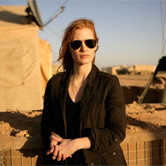Even though it hasn’t even been released from coast-to-coast, Katheryn Bigelow’s new film, Zero Dark Thirty, has been already surrounded by no small amount of controversy. Objections have been raised regarding its depiction of torture, its glorification of war, its blurred moral stance on human rights, its possibly racist depictions of Muslims, its conflicting characterization of feminist vigilantism, its suspected historical untruths and journalistic indiscretions, its flagrant breaching of national secrets, and what might be characterized as callous patriotic blood-lust.
The reason for all of these muddy and uneasy reactions to Bigelow’s movie is that while Zero Dark Thirty appears in the form of an exciting Hollywood movie about the search for and capture of Osama bin Laden, it is equally a challenging critique – of the institutional structures that drove the manhunt, of the structure of human reason and capacity for understanding that deciphered the riddle of bin Laden’s location, of the seek-and-destroy mentality that ended up leading a team of Navy Seals to the hated terrorist leader.
Running a hefty two-hours and forty minutes, the movie is really two movies spliced together. The majority of the film is given to a narrative driven by the character of Maya (Jessica Chastain), a CIA agent recruited “out of high school” and whose entire career in intelligence has been spent trying to track down the al-Qaeda leader. But when the film opens, it has been years since 9-11, and a variety of new terrorist attacks have shaken the reputation of the CIA and turned the organization’s attention to goals other than tracking down the holed-up 9-11 mastermind. Not Maya. With biting determination and impetuous grit, she runs up against her superiors in her obsessive desire to find the terrorist.
On one level, Maya’s story is one we have seen before (Erin Brockovich, The Whistleblower), the female hero who needs to overcome a variety of obstacles — from the protectionist mentality of a government intuition to the boys’ club atmosphere that the female agent must cut through. But what deepens Zero Dark Thirty is how this Hollywood story interfaces with what seems to Bigelow’s larger concerns, that is, the role of torture and rational intuition in tracking down the al-Qaeda leader.
Extended, fascinating scenes of Zero Dark Thirty are given over to convoluted exercises in rational deduction. Intelligence emerges as a game of word-play, and decisions of grave national importance come down to gut-confidence in abstract systems of thinking. Much of the dramatic excitement of Zero Dark Thirty hinges on the working out if something may or may not be the case. And when a supposition isn’t the case, subsequent scenes show car bombs blowing up military bases. It’s one hell of a high-stakes philosophy class.
Set against this word-play, Bigelow takes pains to show us scenes of abject torture. These are unsettling for a variety of reasons, not merely for the fact that cruelty is starkly realized on screen, but because her movie positions the audience in such a way that we begin to identify with Maya’s attempts to gather the information necessary to reach her goal. When the obstacle to that goal involves torture, we are forced into Maya’s essential moral dilemma in an unmediated way.
The scenes also reveal something about Maya too, who, despite our initial suspicions, doesn’t balk at the use of waterboarding on a prisoner. Rather, she bends our expectations of a “feminine” empathy (perhaps revealing them as implicitly sexist), when she uses that very expectation of warmth to manipulate the tortured prisoner’s sense of trust. What emerges is a troubling layering of morals and motivations, one that provides the viewer no clear high ground upon which to stand. Furthermore, it implicates us in the depicted abuse by the very way the distancing of the cinema allows us to withstand – or even enjoy — depictions of abject violence.
The second “movie” in Zero Dark Thirty is the drawn-out reenactment of the siege of Osama bin Laden’s suburban compound. Shot in real time, the excruciating scene provokes, at first, an extended experience of gut-wrenching suspense. But rather than finding release in what our “movie instincts” tell us should be an escalation towards an explosive conclusion, what we get when the helicopters touch-down is a little bit of a letdown. Amidst momentary acts of bravery, the siege is raw and mundane. We watch the killing of woman and children, listening to harrowing screaming, and wait for the thing to be done. Presented in documentary fashion, the death of bin Laden is matter-of-fact and deliberately anti-climactic.
While Zero Dark Thirty is ostensibly a movie about hunting for bin Laden, it is also a piece of entertainment that raises its very entertainment as a crucial point of moral questioning. If hunting and killing bin Laden was a victory for America, than Americans share complicity in the murky and unsettling means to that end. This is war, and as the movie’s nearly real-time battle scene reminds us, war’s exhilarations are mined from war’s essential banality. And Bigelow’s Maya grasps that war is a moral mess that glorifies the application of decisive and uncompromising will. What is less clear, is what happens to our warriors after that will is satiated. The film closes with an unforgettable moment: a lingering shot of Maya alone on a plane, flying from Afghanistan to the United States. She is a hero, but also somehow hollowed-out.





